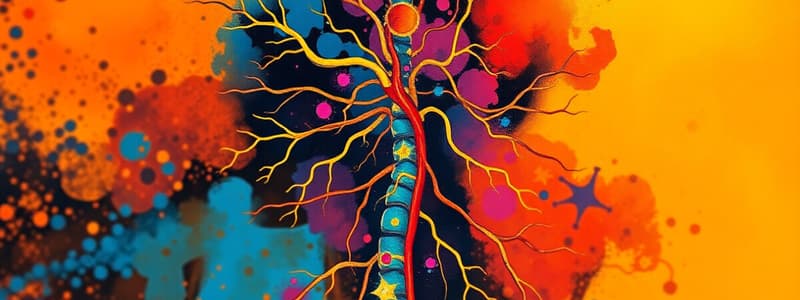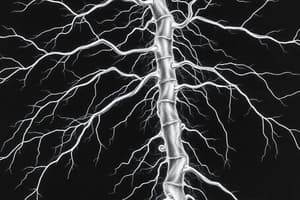Podcast
Questions and Answers
What is the primary function of the central nervous system?
What is the primary function of the central nervous system?
- To regulate body temperature and appetite.
- To carry impulses away from the brain to glands.
- To process information and form a response. (correct)
- To produce enzymes for digestion.
Which of the following is NOT a main region of a neuron?
Which of the following is NOT a main region of a neuron?
- Dendrite
- Cell body
- Synapse (correct)
- Axon
What is the role of motor neurons in the body?
What is the role of motor neurons in the body?
- Regulating body temperature.
- Transmitting signals from receptors to the brain.
- Carrying impulses from the brain to glands or muscles. (correct)
- Processing information within the spinal cord.
Which function is primarily associated with the hypothalamus?
Which function is primarily associated with the hypothalamus?
In which organ does diabetes mellitus occur when it cannot regulate the amount of glucose?
In which organ does diabetes mellitus occur when it cannot regulate the amount of glucose?
What process is initiated if an embryo does NOT implant in the endometrium?
What process is initiated if an embryo does NOT implant in the endometrium?
What is the immediate physiological effect of nicotine?
What is the immediate physiological effect of nicotine?
Which of the following is an example of a stimulant?
Which of the following is an example of a stimulant?
What is the main function of testosterone?
What is the main function of testosterone?
What part of the neuron receives impulses from other neurons?
What part of the neuron receives impulses from other neurons?
How do sensory neurons function within the nervous system?
How do sensory neurons function within the nervous system?
What is the name given to a fertilized egg?
What is the name given to a fertilized egg?
Approximately how long after fertilization does the zygote begin its first mitosis and cell division?
Approximately how long after fertilization does the zygote begin its first mitosis and cell division?
What is one of the main functions of the placenta?
What is one of the main functions of the placenta?
What marks the beginning of adolescence?
What marks the beginning of adolescence?
Which hormones stimulate the gonads to mature?
Which hormones stimulate the gonads to mature?
What is the function of interneurons?
What is the function of interneurons?
What is the largest part of the brain?
What is the largest part of the brain?
Which part of the ear do sound waves first enter?
Which part of the ear do sound waves first enter?
What are the functions of the placenta?
What are the functions of the placenta?
Flashcards
Nervous system
Nervous system
Enables understanding the words you read; consists of receiving, processing and integrating info.
Central Nervous System (CNS)
Central Nervous System (CNS)
Main function is to process information and form a response.
Neurons
Neurons
Specialized nerve cells that transmit electrical signals to organs.
Hypothalamus
Hypothalamus
Signup and view all the flashcards
Motor neurons
Motor neurons
Signup and view all the flashcards
Pancreas
Pancreas
Signup and view all the flashcards
Outer ear
Outer ear
Signup and view all the flashcards
Pregnancy
Pregnancy
Signup and view all the flashcards
Puberty
Puberty
Signup and view all the flashcards
Chemical digestion.
Chemical digestion.
Signup and view all the flashcards
Nicotine
Nicotine
Signup and view all the flashcards
Stimulant
Stimulant
Signup and view all the flashcards
Testosterone
Testosterone
Signup and view all the flashcards
Dendrites
Dendrites
Signup and view all the flashcards
Sensory neurons
Sensory neurons
Signup and view all the flashcards
Zygote
Zygote
Signup and view all the flashcards
Placenta
Placenta
Signup and view all the flashcards
Adolescence
Adolescence
Signup and view all the flashcards
Luteinizing hormone (LH)
Luteinizing hormone (LH)
Signup and view all the flashcards
Effect of nicotine
Effect of nicotine
Signup and view all the flashcards
Study Notes
- The nervous system enables understanding of written words.
- Two major systems: central and prefrontal.
- The nervous system consists of three roles: receiving information, processing, and integrating responses.
- The central nervous system's (CNS) function is to process information and form a response.
- The brain and the spinal cord comprises the central nervous system.
- Neurons are specialized nerve cells that help gather, interpret information, and react to it.
- Neurons transmit electrical signals to various organs inside the body.
- Neurons consists of three main regions: the dendrites, the cell body, and an axon.
- The hypothalamus regulates body temperature, thirst, appetite, and water balance.
- The hypothalamus partially regulates blood pressure, sleep, aggression, fear, and sexual behavior and when you are hungry.
- Motor neurons carry impulses away from the brain and spinal cord to a gland or muscles, resulting in a secretion or movement.
- For example, the motor neuron stimulates the arm to move or sweat.
- The pancreas is involved in the production of enzymes that digest carbohydrates, proteins, and fats and also secretes the hormones, insulin, and glucagon to maintain homeostasis and the level of sugar in the blood.
- Diabetes mellitus occurs when the pancreas fails to regulate the amount of glucose in the blood.
- The nervous system receives information from the nervous system and initiates responses through the endocrine system.
- During menstruation, if an embryo does not implant in the endometrium, the endometrium is shed in a process called menstruation.
- Menstruation cycle will not occur if the egg is fertilized.
- Adolescence starts at puberty.
- Menstrual cycle lasts 5-7 days, with 28 days between cycles.
- The mensural cycle stops the cycle if pregnancy .
- Menstrual cycle includes flow, fleigual, and luteal phases.
- Chemical digestion begins in the mouth with saliva breaking down food.
- Digestive enzymes break down food.
- Nicotine increases the amount of dopamine released into a synapse and can cause constricted blood flow. Its immediate effect is constricted blood vessels.
- Stimulants are drugs that increase alertness and physical activity.
- Coffee is an example of a stimulant.
- Testosterone is a steroid hormone that is necessary for the production of sperm and influences sex characteristics during puberty.
- Secondary sex characteristics include facial chest, broader shoulders, increased muscle movement and a deep voice.
- Dendrites receive impulses from other neurons and conduct impulses to the cell body which contains the nucleus and other organelles.
- The axon passes those impulses on to other neurons or muscles.
- There are 3 kinds of Sensory neurons, interneurons and motor neurons.
- Sensory neurons send impulses from receptors in the skin and sense organs to the brain and spinal cord.
- Interneurons carry impulses to motor organs.
- A zygote is a fertilized egg.
- About 30 hours after fertilization, the zygote undergoes its first mitosis and cell division
- The placenta provides food and oxygen and removes waste. Connects the mother and the baby.
- The placenta has two surfaces: a detail side that forms from the chorion and faces the fetus, and a maternal side that forms from the uterine tissue
- One of the function of placenta is to provide nutrients to fetus.
- Puberty the period of growth when sexual maturity is reached and begins during adolescence
- Follicle-stimulating hormone (FSH) in addition to Luteinizing hormone (LH) stimulate the gonads to mature and produce hormones male and female characteristics.
- Increased heart rate and blood pressure is an immediate effect of nicotine.
- The Cerebrum is the largest part of the brain.
- The outer ear -specifically in the pinna tube also called the auditory canal- is the part of the ear where sound waves first enter.
- Vibrations trigger an impulse (signals) from sound waves.
- The placenta provides oxygen and nutrients to the fetus, removes waste products from the fetus' blood, and produces hormones to support pregnancy.
- The central nervous system enables understanding of written words in a book.
- The function of the nervous system: to receive, process, and respond, to sensory input, and to control body functions and actions.
Studying That Suits You
Use AI to generate personalized quizzes and flashcards to suit your learning preferences.




